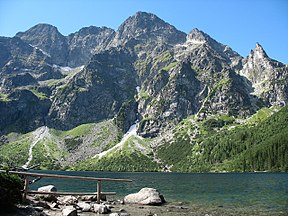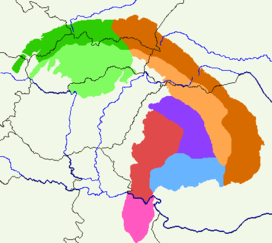| Carpathians | |
|---|---|
 | |
| Highest point | |
| Peak | Gerlachovský štít |
| Elevation | 2,655 m (8,711 ft) |
| Dimensions | |
| Length | 1,700 km (1,100 mi) |
| Naming | |
| Native name | |
| Geography | |
| Countries | |
| Range coordinates | 47°00′N 25°30′E / 47°N 25.5°E |
| Borders on | Alps |

The Carpathian Mountains or Carpathians (/kɑːrˈpeɪθiənz/) are a range of mountains forming an arc across Central Europe and Southeast Europe. Roughly 1,500 km (930 mi) long, it is the third-longest European mountain range after the Urals at 2,500 km (1,600 mi) and the Scandinavian Mountains at 1,700 km (1,100 mi). The range stretches from the far eastern Czech Republic (3%) and Austria (1%) in the northwest through Slovakia (21%), Poland (10%), Ukraine (10%), Romania (50%) to Serbia (5%) in the south.[1][2][3][4] The highest range within the Carpathians is known as the Tatra Mountains in Poland and Slovakia, where the highest peaks exceed 2,600 m (8,500 ft). The second-highest range is the Southern Carpathians in Romania, where the highest peaks range between 2,500 m (8,200 ft) and 2,550 m (8,370 ft).
The divisions of the Carpathians usually involve three major sections:[5]
- Western Carpathians: Austria, Czech Republic, Poland and Slovakia
- Eastern Carpathians: southeastern Poland, eastern Slovakia, Ukraine, and Romania
- Southern Carpathians: Romania and eastern Serbia[1][2][4]
The term Outer Carpathians is frequently used to describe the northern rim of the Western and Eastern Carpathians.
The Carpathians provide habitat for the largest European populations of brown bears, wolves, chamois, and lynxes, with the highest concentration in Romania,[6][7][8] as well as over one-third of all European plant species.[9] The mountains and their foothills also have many thermal and mineral waters, with Romania having one-third of the European total.[10][11] Romania is likewise home to the second-largest area of virgin forests in Europe after Russia, totaling 250,000 hectares (65%), most of them in the Carpathians,[12] with the Southern Carpathians constituting Europe's largest unfragmented forest area.[13] Deforestation rates due to illegal logging in the Carpathians are high.[14]
- ^ a b [1] Archived 12 October 2017 at the Wayback Machine "The Carpathians" European Travel Commission, in The Official Travel Portal of Europe, Retrieved 15 November 2016
- ^ a b [2] Archived 19 November 2016 at the Wayback Machine The Carpathian Project: Carpathian Mountains in Serbia, Institute for Spatial Planning, Faculty of Geography, University of Belgrade (2008), Retrieved: 15 November 2016
- ^ [3] Archived 1 August 2019 at the Wayback Machine Bulletin of the Natural History Museum, pg. 54, Valuing the geological heritage of Serbia (UDC: 502.171:55(497.11), Aleksandra Maran (2010), Retrieved 15 November 2016
- ^ a b Paun Es Durlić (2011). Sacred Language of the Vlach Bread. Balkankult. ISBN 9788684159290. Archived from the original on 29 January 2018. Retrieved 15 November 2016.
- ^ About the Carpathians – Carpathian Heritage Society Archived 6 April 2010 at the Wayback Machine
- ^ Peter Christoph Sürth. "Braunbären (Ursus arctos) in Europa". Archived from the original on 15 August 2008. Retrieved 10 March 2011.
- ^ Peter Christoph Sürth. "Wolf (Canis lupus) in Europa". Archived from the original on 15 August 2008. Retrieved 10 March 2011.
- ^ Peter Christoph Sürth. "Eurasischer Luchs (Lynx lynx) in Europa". Archived from the original on 15 August 2008. Retrieved 10 March 2011.
- ^ "Carpathian montane conifer forests – Encyclopedia of Earth" (MediaWiki). www.eoearth.org. Retrieved 4 August 2010.
- ^ București, stațiune balneară – o glumă bună? Archived 14 March 2012 at the Wayback Machine in Capital, 19 January 2009. Retrieved: 26 April 2011
- ^ Ruinele de la Baile Herculane si Borsec nu mai au nimic de oferit Archived 13 July 2019 at the Wayback Machine in Ziarul Financiar, 5 May 2010. Retrieved: 26 April 2011
- ^ Salvați pădurile virgine! Archived 27 October 2011 at the Wayback Machine in Jurnalul Național, 26 October 2011. Retrieved: 31 October 2011
- ^ Europe: New Move to Protect Virgin Forests in Global Issues, 30 May 2011. Retrieved 31 October 2011.
- ^ Neslen, Arthur (31 May 2018). "Romania breaks up alleged €25m illegal logging ring". The Guardian. ISSN 0261-3077. Retrieved 11 July 2019.
